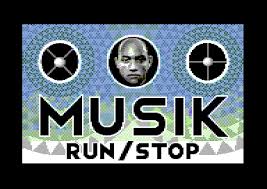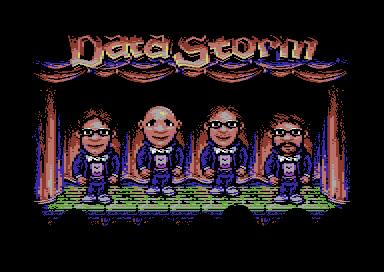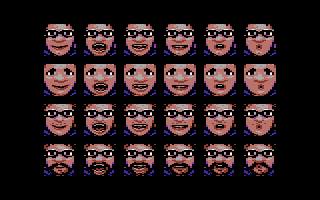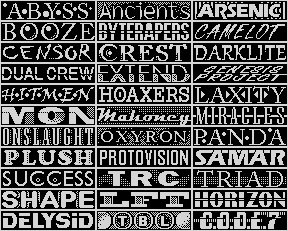The Making of Musik Run/Stop and We Are All Connected
Written by Magic of Nah-Kolor
Hugi went behind the Commodore 64 curtains to zoom in on two magnificient demos from Datastorm 2014.
Datastorm 2014 delivered a very great Commodore 64 demo competition. This article is about the making of the winning
demo of this competition called "We Are All Connected" by Fairlight, Offence and Prosonix. Also the making of Mahoney's
new demo called "Musik Run Stop" is featured in this article. Hence we start with it.
Musik Run/Stop
 Musik Run/Stop has some of the best quality samples ever on a Commodore 64. If not the best. How did the project
for this demo start? And what happened during the developement process? But perhaps most interesting of all: what's
there to tell about the technical side of this demo? "Well, it started with the Monophono track I did for
Datastorm 2013. I had real trouble in getting the filter changes 'smooth' enough to be in the song. I had trouble
in turning the filter on/off on the channels without getting some really loud clicks. But, there must be a reason
for those clicks, I thought, and started reading my own SID software emulation code I wrote a year earlier -
and after some measurement on a real 6581 SID chip I realised that the analog SID filters actually have an
amplification factor of approximately -1. Which means, a signal of amplitude 1 into the filter will give a
signal with the amplitude of -1 out of it. So, let's feed the filter with the highest signal we could come up
with, which is all voices with a pulse waveform with the test bit set. An additional bonus on the 6581 chips is
that the offset voltages of the voices will add up as well. And switch between routing those voices though the
filter or around it. And, yes, we did get clicks, as loud as ever. After some more thinking, I realised that this
could be used for something more useful than clicking. And with the help of Uwe 'THCM' Anfang, we started measuring
up a couple of SID chips to try to get an overview of the subtle analog manufacturing differences, and through
clever use of statistics be able to determine which combination of volume/hp/lp/bp-filter and voice 3 routing
to use to get good quality samples out of the SID chip. As a coincidence, all these control bits resides in
the same byte - the world famous $d418 register! So, three weeks before the Datastorm party, we did have
44.1kHz samples playing. But not much else", Mahoney tell us and continues: "But, we've got friends, and Prowler,
Magnar and Veto helped us out in making graphics and audio - so we spent some long nights in getting together
two disc sides of demo. And I'd say since it wasn't the first time any of us put together a large trackloading
demo, things went much smoother than anticipated. And this demo was kind of designed around the music/audio."
Musik Run/Stop has some of the best quality samples ever on a Commodore 64. If not the best. How did the project
for this demo start? And what happened during the developement process? But perhaps most interesting of all: what's
there to tell about the technical side of this demo? "Well, it started with the Monophono track I did for
Datastorm 2013. I had real trouble in getting the filter changes 'smooth' enough to be in the song. I had trouble
in turning the filter on/off on the channels without getting some really loud clicks. But, there must be a reason
for those clicks, I thought, and started reading my own SID software emulation code I wrote a year earlier -
and after some measurement on a real 6581 SID chip I realised that the analog SID filters actually have an
amplification factor of approximately -1. Which means, a signal of amplitude 1 into the filter will give a
signal with the amplitude of -1 out of it. So, let's feed the filter with the highest signal we could come up
with, which is all voices with a pulse waveform with the test bit set. An additional bonus on the 6581 chips is
that the offset voltages of the voices will add up as well. And switch between routing those voices though the
filter or around it. And, yes, we did get clicks, as loud as ever. After some more thinking, I realised that this
could be used for something more useful than clicking. And with the help of Uwe 'THCM' Anfang, we started measuring
up a couple of SID chips to try to get an overview of the subtle analog manufacturing differences, and through
clever use of statistics be able to determine which combination of volume/hp/lp/bp-filter and voice 3 routing
to use to get good quality samples out of the SID chip. As a coincidence, all these control bits resides in
the same byte - the world famous $d418 register! So, three weeks before the Datastorm party, we did have
44.1kHz samples playing. But not much else", Mahoney tell us and continues: "But, we've got friends, and Prowler,
Magnar and Veto helped us out in making graphics and audio - so we spent some long nights in getting together
two disc sides of demo. And I'd say since it wasn't the first time any of us put together a large trackloading
demo, things went much smoother than anticipated. And this demo was kind of designed around the music/audio."
Interesting enough, the Musik Run/Stop demo itself was put together just in a few days before Datastorm 2014.
Mahoney explains: "First we did the music routines, and it wasn't until the audio was as good as we wanted it
to be that we knew how much memory/loading time/etc we could spend for making the visuals. Now, compare this
with any other Datastorm c64 demo from 2014 - Censor Design, Triad, Fairlight/Offence/Prosonix, all of them
started with the graphics effects, and then decided how much memory and CPU time the music routine was allowed
to take. Well smooth, except that we did deliver the final version of the demo some 15 minutes before it was
shown on the big screen in the Datastorm demo competition."
 So why was the Musik Run/Stop demo delivered so late for the compo? Mahoney told me because a lot of things went
down and have been added to the demo just in the last 30 hours before the deadline. Mahoney sums up:
So why was the Musik Run/Stop demo delivered so late for the compo? Mahoney told me because a lot of things went
down and have been added to the demo just in the last 30 hours before the deadline. Mahoney sums up:
1. Transition from basic into the first text.
2. Transition to get the eyes on the screen.
3. Animation of the talking eyes.
4. Level adjustments on the talking eyes.
5. Removed some clicks between speech and song.
6. Added a "TURN DISC" part.
7. Fixed the transition from the turn disc part into the a cappella singing.
8. Added animation to the a cappella part.
9. Added the Datastorm logo above the a cappella singers.
10. Wrote the scrolltext.
11. Added the credits screen.
12. Made a remix of Mahoney's Monophono song, without samples but with an added third SID channel.
13. Tested the release on the compo machine and on a separate 8580 machine.
"...so it was kind of productive last hours before the deadline. And I personally think it turned out quite alright!"
Mahoney concludes.
Next to all samples and music Mahoney created for the Musik Run/Stop demo also Magnar of Censor Design was credited
for doing music. What did Magnar do then? What can Magnar tell us about the music in the Musik Run/Stop demo?
Magnar: "Oh, that's a question for Mahoney. I just made two small sids to hide away some of the loading times I
don't think anyone actually noticed the sids at all. It's all about the samples. But the samples are special
because of the new techniques used for the playback."


Having focused on the music/audio part of the demo we could almost forget there are some very nice graphics in
this demo as well. Next to Mahoney also Prowler of Up Rough and Veto of Oxyron are responsible. Hugi got in an
exclusive talk with Veto about his graphics in the Musik Run/Stop demo. "For this demo I was initially
asked by The Human Code Machine to create graphics for an a capella part. The human code machine is the guy
who coded the converter for amiga mods to get them playable on a commodore 64. He was also involved in the
Vicious Sid demo project and was also responsible for the digi sound routine in coma light 13. He is mainly
a member of Masters Design Group", Veto explains and continues: "Right from the start there was also the
idea to create somehow a hommage to the classic 'thrust concert'. So there should be a stage and four
animated singers. What makes this a bit special is that tune which is used in that demo which uses sound
samples only. Heavy on memory, heavy on rastertime. Practically speaking this means that bitmap graphics
and sprite animations are not a good choice. So it needed to be done in charmode. Charmode is typically
used in commodore 64 games as background graphics. 256 chars where abc are defined as tiny puzzle pieces.
256 chars is not quite enough to create a full screen stage, but thanks to the coder I was able to split the
screen to three individual sets. Ehm... correction. The bottom set was restricted to 192 characters
because this was also shared with the scrolltext. The graphics itself was pixelled with the windows
tool 'pro motion', which is kind of a big sudoku thing. The commodore 64 screen is devided in a matrix
40 character columns and 25 lines. You are free to choose one individual color and between 2 resolutions
for each block. 8x8 pixels with 2 colors or 4x8 pixels with 4 colors. To keep it short - the work consists
of artistic part and counting colors and tiles. The cool thing about pro motion is that this tool supports
animation. So it was also perfect to create animated areas for the singers. When the creation was done it
was necessary to process the graphics for the coder. The screen was split in three parts including the
animation frames for each character set plus a list for the animation frames sorted by the assigned
music samples. Those pieces were put together by the coder who also synched the animation with the music
and this is what you see in the final demo."
Download at csdb.
Musik Run/Stop on Youtube
We are all connected by Fairlight, Offence and Prosonix




The mighty threesome Fairlight, Offence and Prosonix gave birth to yet another big Commodore 64 demo. "We are all
connected" won the Datastorm 2014 demo competition. Let's start with some detailed credits. Intro code, music and
graphics by Kriburst. The long scroller + effects on side 1 coded by Perlex with music by Scarzix and graphics by
Pal. The fadeout and greetings part on side 1 was coded by Pantaloon with music by Groms and again graphics by Pal.
Everything on side 2 was coded by Pantaloon. The music was composed by Wiklund with graphics by Pal & Pantaloon.
Then is there is side 3. The long scroller was coded by Perplex with graphics by Pal and music by Scarzix.
The 'voxelscroller' and the 'rotating head' was coded by Pantaloon. Music score by Ole and Pal did the graphics.
To conclude the game to save the Datastorm 2014 partyplace 'Truckstop Alaska'. Everything was done by Stein.
Pal's graphics in "We Are All Connected" are high resolution. The whole demo breath high resolution. What is it about
this graphics mode on the Commodore 64 that makes "We Are All Connected" so special? Hugi contacted Pal of Offence to
find out. Pal: "Well, I have always been a multicolour artist, double pixels are for me what the c64 is mostly.
So I decided to have a go at high-res because I really did only one high-res graphic in my past on the c64 beside
charsets and so on. To my surprise I really liked working in high-res mode, with only one colour and background
per char, so the graphics, all graphics in we are all connected are made in plain high-res and Kristian made the
fantastic tornado intro gfx himself, also high-res. It is long ago I have been so surprised about the results and
I tested a lot but I had to do it my own way so I dropped what I had made and went for a more simple approach with
making it almost monochromic but with my touch and stamp into it and choosing colours carefully instead of making
a lot of colour ranges and showing off how nerdy good I can be to hold more colours than the next I think I just
did it my way instead, very happy about that!"
The long scroller graphics on side 1 and side 3 were truely spectacular in the eyes of Hugi. We asked Pal to shine
a light about the process in which he created those multi screen logos. "Well, it is maybe a strange process for
some but for me it is logical. I do not set out to make it this or that... I just start making something and in the
end it is what it is. It is the Holy Grail of what I do on the demos and for our demos and in all scene activities
that I do... I do not want it as a job or something that can be feeling as a job. If it gets there I end up with
two jobs and that I do not want. So for me it is about making creating and doing what fits me at this very moment
instead of making one sketch that is so fun to do in a few days and then start to go on a job every day to
finish that two days of fun..." Pal tells us and continues: "I want the whole process to be fun, free and spontaneous...
that is what demo parts and these things are about for me... When you show a part to another scener they respond
with yeahhh... what about borders? What about more colours? What about moving that in animation... it is all
spontaneous feedbacks there and then... it is nothing planned and nothing that one can really plan, I want that in
the creation process of demos. TO HAVE FUN AND TAKE IT AS THAT! It is the best to show new stuff for my friends
in the forom we have instead of showing them just better pixeling this little part of something they knew about
months ago... that is no fun. But at some point it gets to be about making what one do have even better of course
and Stein said to me... you posted 40 versions in a week of that linge image and I do not see the difference... lol... but
that is how it gets at some point."
To conclude our conversation with Pal about We Are All Connected we tried to find out in general what he had to
say about other making of elements of this demo. Pal surely had some small story ready for us. Pal: "That we did
the demo in superspeedway style actually, we just did hammer it together in stone like it just were meant to turn
out that way no matter what. Everyone were so determent and we helped each other to make it great, of course we
had the bugs in the last days and had to release a bit shortened version in gfx as we got some nastiness we
could not fix with the graphics. But timeframe vice it would have been the same. It was a blast putting it together
in shorter time than our Scrollwars demo even, if you look at things except some code tests and the long images.
When we decide to do stuff I think there is no greater team than us on this planet, things fall in place in a
magical way."
There is also alot of SID music in the We Are All Connected demo. We had a short thoughts exchange with Wiklund
of Fairlight about his music on side 2. Wiklund shared some nice intel on the making of his music.
Wiklund: "It was a lot of fun as always, I synced the demo while i was in the Netherlands, hehe. I used GoatTracker
v2.71 by Cadaver, I remember I tried to make it to not sound so chippy. I think thats a really good 'rule' when you
are makeing .SIDs. But it's always fascinating to see the development stage from start to end. I also had mixed
feelings because we started on the demo quite late, but I'm very satisfied with the production."
Finally Pantaloon of Fairlight airs his thoughts on We Are All Connected and the making of this demo. "We Are All Connected
started out quite odd. I was planning of making my own FairLight only demo and the Offence guys were planning to do
an Offence demo for Datastorm. But both FairLight and Offence had some trouble getting going with 2 demos.
So we agreed on doing yet another FairLight + Offence + Prosonix demo. It turned out quite good and it's always
a pleasure working with the Offence dudes", Pantaloon explains and continues: "I had most of the effects
for Side-B done but got lots of help from Pal graphics wise to complete them. The morphing credits turned
out really nice, it was Scarzix who showed an idea with static heads and names, then I tought of morphing the
heads and I got it working within a few hours. The trickiest part I coded for this demo was the star with the
colliding physics ontop, it's all realtime and i have plans to make it even more dynamic and fun in the future."
Download at csdb.
We are all connected on Youtube
Magic



 Musik Run/Stop has some of the best quality samples ever on a Commodore 64. If not the best. How did the project
for this demo start? And what happened during the developement process? But perhaps most interesting of all: what's
there to tell about the technical side of this demo? "Well, it started with the Monophono track I did for
Datastorm 2013. I had real trouble in getting the filter changes 'smooth' enough to be in the song. I had trouble
in turning the filter on/off on the channels without getting some really loud clicks. But, there must be a reason
for those clicks, I thought, and started reading my own SID software emulation code I wrote a year earlier -
and after some measurement on a real 6581 SID chip I realised that the analog SID filters actually have an
amplification factor of approximately -1. Which means, a signal of amplitude 1 into the filter will give a
signal with the amplitude of -1 out of it. So, let's feed the filter with the highest signal we could come up
with, which is all voices with a pulse waveform with the test bit set. An additional bonus on the 6581 chips is
that the offset voltages of the voices will add up as well. And switch between routing those voices though the
filter or around it. And, yes, we did get clicks, as loud as ever. After some more thinking, I realised that this
could be used for something more useful than clicking. And with the help of Uwe 'THCM' Anfang, we started measuring
up a couple of SID chips to try to get an overview of the subtle analog manufacturing differences, and through
clever use of statistics be able to determine which combination of volume/hp/lp/bp-filter and voice 3 routing
to use to get good quality samples out of the SID chip. As a coincidence, all these control bits resides in
the same byte - the world famous $d418 register! So, three weeks before the Datastorm party, we did have
44.1kHz samples playing. But not much else", Mahoney tell us and continues: "But, we've got friends, and Prowler,
Magnar and Veto helped us out in making graphics and audio - so we spent some long nights in getting together
two disc sides of demo. And I'd say since it wasn't the first time any of us put together a large trackloading
demo, things went much smoother than anticipated. And this demo was kind of designed around the music/audio."
Musik Run/Stop has some of the best quality samples ever on a Commodore 64. If not the best. How did the project
for this demo start? And what happened during the developement process? But perhaps most interesting of all: what's
there to tell about the technical side of this demo? "Well, it started with the Monophono track I did for
Datastorm 2013. I had real trouble in getting the filter changes 'smooth' enough to be in the song. I had trouble
in turning the filter on/off on the channels without getting some really loud clicks. But, there must be a reason
for those clicks, I thought, and started reading my own SID software emulation code I wrote a year earlier -
and after some measurement on a real 6581 SID chip I realised that the analog SID filters actually have an
amplification factor of approximately -1. Which means, a signal of amplitude 1 into the filter will give a
signal with the amplitude of -1 out of it. So, let's feed the filter with the highest signal we could come up
with, which is all voices with a pulse waveform with the test bit set. An additional bonus on the 6581 chips is
that the offset voltages of the voices will add up as well. And switch between routing those voices though the
filter or around it. And, yes, we did get clicks, as loud as ever. After some more thinking, I realised that this
could be used for something more useful than clicking. And with the help of Uwe 'THCM' Anfang, we started measuring
up a couple of SID chips to try to get an overview of the subtle analog manufacturing differences, and through
clever use of statistics be able to determine which combination of volume/hp/lp/bp-filter and voice 3 routing
to use to get good quality samples out of the SID chip. As a coincidence, all these control bits resides in
the same byte - the world famous $d418 register! So, three weeks before the Datastorm party, we did have
44.1kHz samples playing. But not much else", Mahoney tell us and continues: "But, we've got friends, and Prowler,
Magnar and Veto helped us out in making graphics and audio - so we spent some long nights in getting together
two disc sides of demo. And I'd say since it wasn't the first time any of us put together a large trackloading
demo, things went much smoother than anticipated. And this demo was kind of designed around the music/audio."
 So why was the Musik Run/Stop demo delivered so late for the compo? Mahoney told me because a lot of things went
down and have been added to the demo just in the last 30 hours before the deadline. Mahoney sums up:
So why was the Musik Run/Stop demo delivered so late for the compo? Mahoney told me because a lot of things went
down and have been added to the demo just in the last 30 hours before the deadline. Mahoney sums up:








